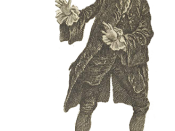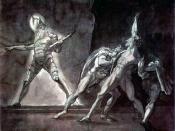Hamlet as a Tragic Hero
William Shakespeare, the greatest playwright of the English language, wrote a total of 37 plays in his lifetime, all of which can be categorized under tragedy, comedy, or history. The Tragedy of Hamlet, Shakespeare's most popular and greatest tragedy, displays his genius as a playwright, as literary critics and academic commentators have found an unusual number of themes and literary techniques present in Hamlet. Hamlet concerns the murder of the king of Denmark and the murdered king's son's quest for revenge. Its main character, Hamlet, possesses a tragic flaw which obstructs his desire for revenge and ultimately brings about his death. This tragic flaw makes him a tragic hero, a character who is destroyed because of a major weakness, as his death at the end could possibly have been avoided were it not for his tragic flaw. Hamlet's flaw of irresolution, the uncertainty on how to act or proceed, is shown when Hamlet sees a play and the passion the actors had, after Hamlet's third soliloquy, in Hamlet's fourth soliloquy, and in Hamlet's indecisive pursuit in avenging his father's death.
First, Hamlet's flaw of irresolution is shown when he sees a play and the passion one particular actor had. A group of players has arrived and Hamlet arranges a personal viewing of The Murder of Gonzago with a small portion of his own lines inserted. Hamlet then observes one portion of the play in which one of the players put on a great display of emotion. Hamlet, besieged by guilt and self-contempt, remarks in his second soliloquy of Hamlet of the emotion this player showed despite the fact that the player had nothing to be emotional about. Hamlet observed that he himself had all the reason in the world to react with great...


